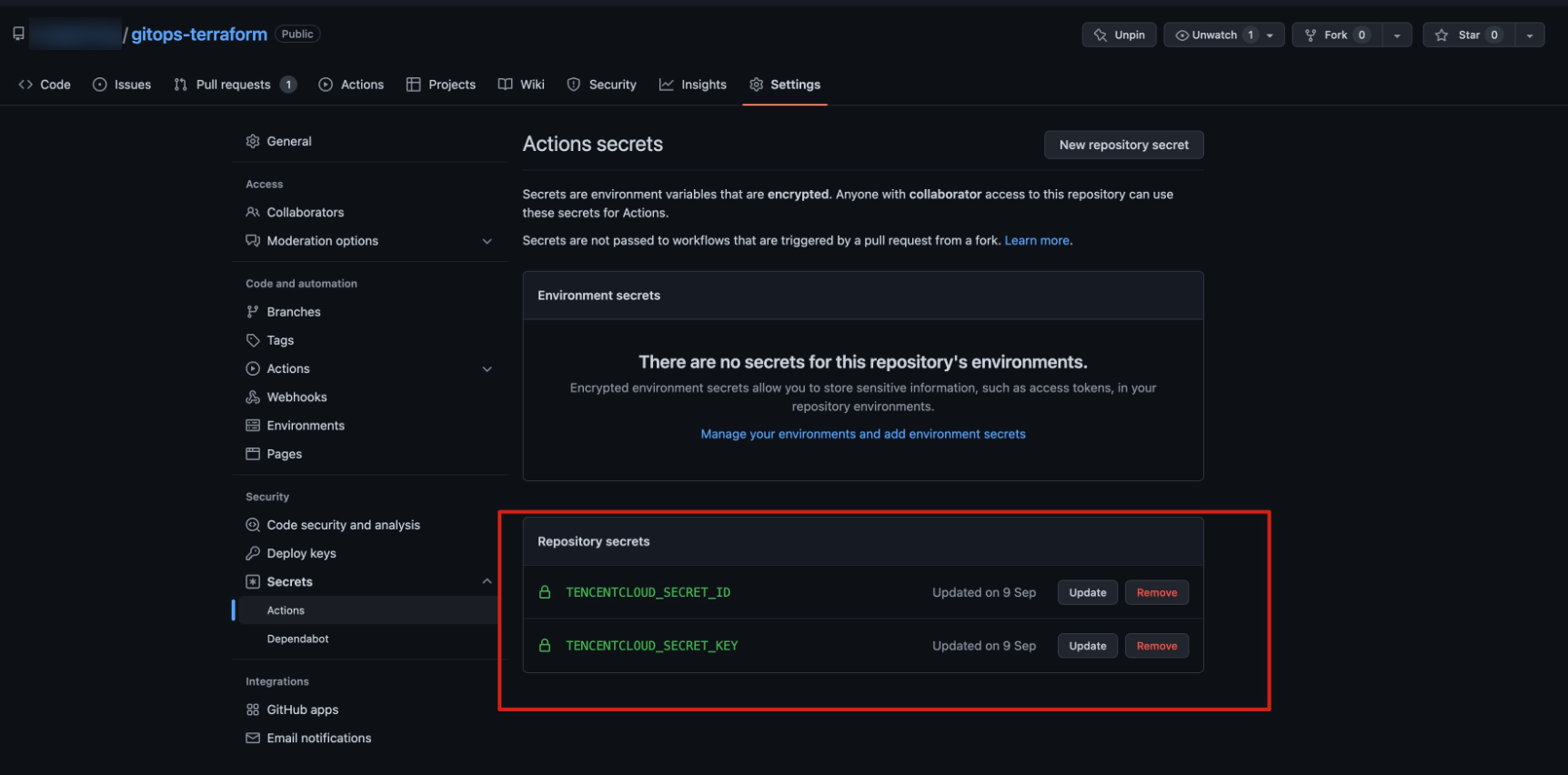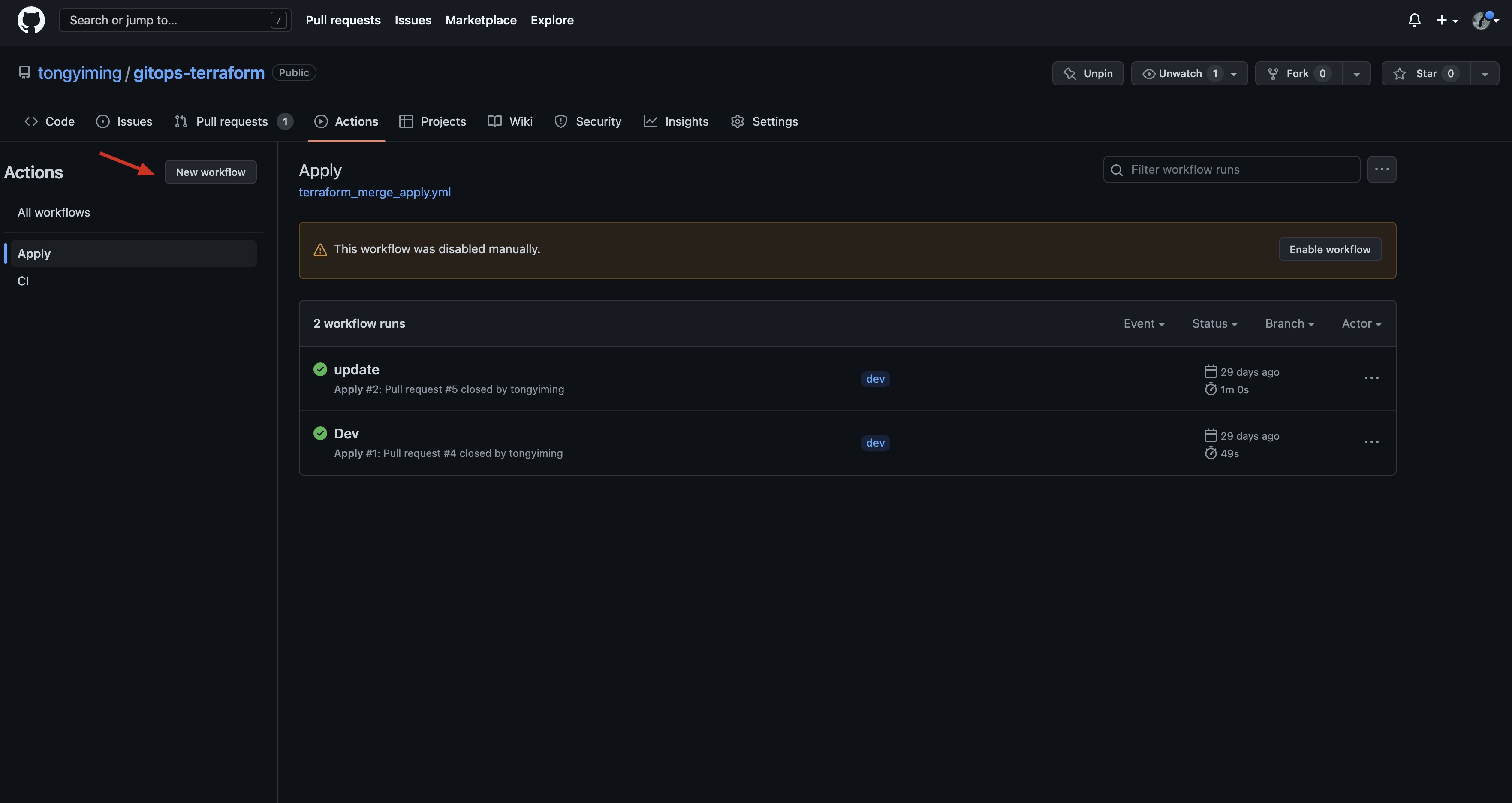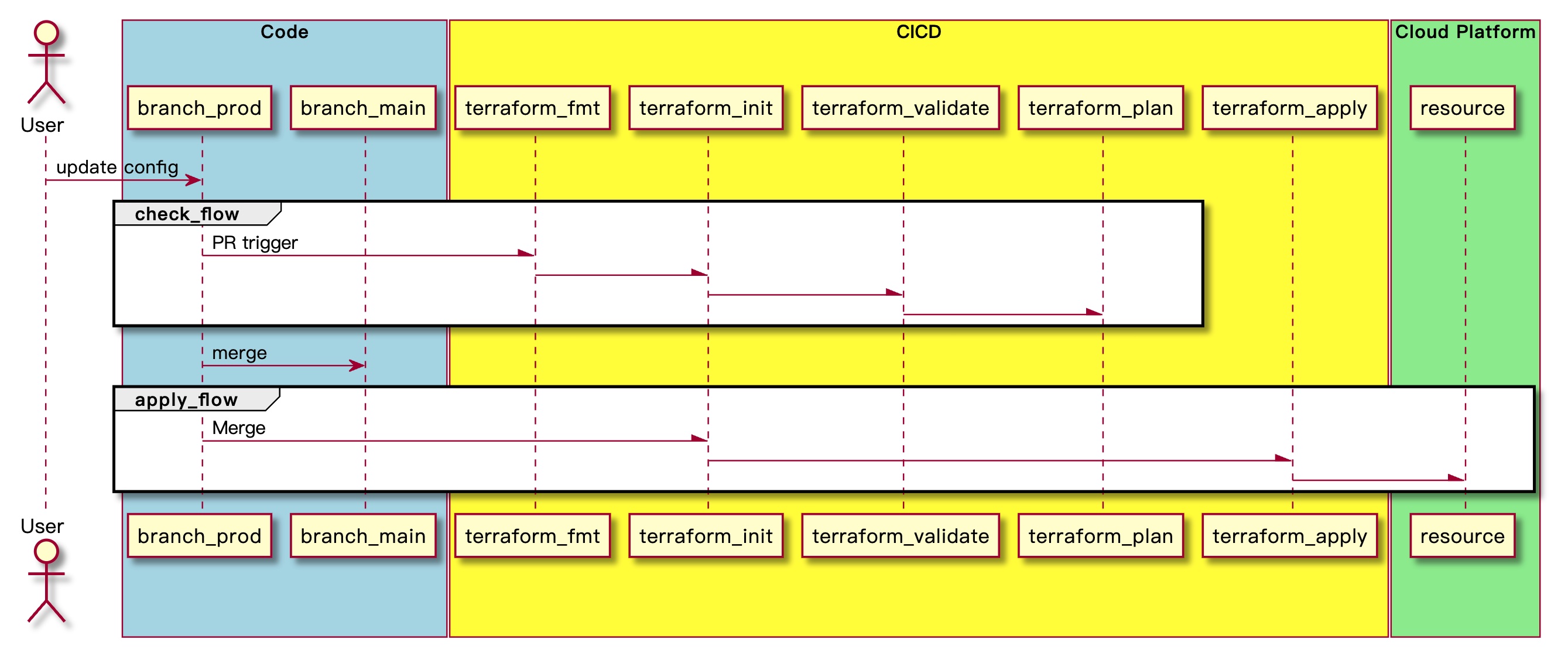This document describes how to implement automated deployment with Terraform and GitHub Actions.
Prerequisites
Register at GitHub.
Register at Tencent Cloud.
Get the credentials. Create and copy
SecretIdandSecretKeyon the Manage API Key page.
Creating a Project
Create a code repository on GitHub. Below is the directory structure:
.
├── README.md
├── environments
│ ├── dev
│ │ ├── main.tf
│ │ └── provider.tf
│ └── prod
│ ├── cicd
│ │ └── main.tf
│ ├── local.tf
│ ├── main.tf
│ ├── provider.tf
│ └── qta
│ └── main.tf
└── modules
├── network
│ ├── main.tf
│ ├── outputs.tf
│ ├── provider.tf
│ └── variables.tf
├── security_group
│ ├── main.tf
│ ├── outputs.tf
│ ├── provider.tf
│ └── variables.tf
└── tke
├── main.tf
├── outputs.tf
├── provider.tf
└── variables.tf
Directory structure description:
The project structure mainly consists of
environmentsandmodulesdirectories.The
environmentsdirectory isolatesdevandprodenvironments and sets different configurations for different environments. Each environment directory is an independent root module.Note:devdemonstrates how to create a VPC.proddemonstrates how to isolate businesses throughworkspace. VPCs are created in thecicddirectory, and container clusters are created in theqtadirectory.
modulesencapsulates resource information for reuse. Here, it contains demo modules of the VPC, security group, and TKE.For the complete code, see gitops-terraform.
Workflow Configuration
To avoid security issues due to AK/SK leakage, you need to set environment variables in
https://github.com/${USER}/${PROJECT}/settings/secrets/actions. Replace the secrets with the copiedSecretIdandSecretKey.
Configure the workflow through GitHub Actions.
Click New workflow next to Actions, or create a workflow by adding a YAML file in the
.github/workflows/directory. For more information on the workflow configuration, see Related Operations.
Check workflow
Terraform should not have too many root module resources. Similarly, avoid reading all resources during a check, which should be triggered in a fine-grained manner.
In this document, environments are distinguished by branch. For example, if the configuration in the
devbranch needs to be updated, the update will be triggered only indev. After the configuration update, submit the pull request and merge the code intomain(main branch). In this way, the system does not need to scan all the sub-directories ofenvironmentsfor update checks, reducing unnecessary state sync operations.The workflow mainly runs
terraform fmt,terraform init,terraform validate, andterraform planto check the code and display the build plan, so as to determine whether to execute the deployment.
Deployment workflow
If all operations in the check workflow are successful and the output of
terraform planis as expected, you can perform the merge operation.After the merge is completed, trigger the deployment operation (i.e.,
terraform apply) as shown below:

Related Operations
After the environment directory specified by environment is entered, the system will check whether a sub-directory exists, and if so, the system will isolate different business environments (such as qta and ci) through workspace; if not, the specified directory is equivalent to a common root module.
Creating a check workflow
Download Terraform and verify the Terraform code as follows:
# This is a basic workflow to help you get started with Actions
name: CI
# Controls when the workflow will run
on:
pull_request:
# A workflow run is made up of one or more jobs that can run sequentially or in parallel
jobs:
# This workflow contains a single job called "build"
build:
# The type of runner that the job will run on
runs-on: ubuntu-latest
env:
TENCENTCLOUD_SECRET_KEY: ${{ secrets.TENCENTCLOUD_SECRET_KEY }}
TENCENTCLOUD_SECRET_ID: ${{ secrets.TENCENTCLOUD_SECRET_ID }}
# Steps represent a sequence of tasks that will be executed as part of the job
steps:
- uses: actions/checkout@v3
- uses: hashicorp/setup-terraform@v2
with:
terraform_wrapper: false
- name: check env
run: |
if [ ! -d "environments/$GITHUB_HEAD_REF" ]; then
echo "*************************SKIPPING************************************"
echo "Branch '$GITHUB_HEAD_REF' does not represent an oficial environment."
echo "*********************************************************************"
exit 1
fi
- name: terraform fmt
id: fmt
run: terraform fmt -recursive -check
- name: terraform init
id: init
working-directory: environments/${{ github.head_ref }}
run: terraform init
- name: terraform validate
id: validate
working-directory: environments/${{ github.head_ref }}
run: terraform validate
- name: terraform plan
id: plan
if: github.event_name == 'pull_request'
working-directory: environments/${{ github.head_ref }}
run: |
plan_info=""
dir_count=`ls -l | grep "^d" | wc -l`
if [ $dir_count -gt 0 ]; then
for dir in ./*/
do
env=${dir%*/}
env=${env#*/}
echo ""
echo "========> Terraform Plan <========"
echo "At environment: ${{ github.head_ref }}"
echo "At workspace: ${env}"
echo "=================================="
terraform workspace select ${env} || terraform workspace new ${env}
plan_info="$plan_info\n$(terraform plan -no-color)"
done
else
plan_info="$(terraform plan -no-color)"
fi
plan_info="${plan_info//'%'/'%25'}"
plan_info="${plan_info//$'\n'/'%0A'}"
plan_info="${plan_info//$'\r'/'%0D'}"
echo "::set-output name=plan_info::$plan_info"
continue-on-error: true
- uses: actions/github-script@v6
if: github.event_name == 'pull_request'
with:
script: |
const output = `#### Terraform Format and Style \`${{ steps.fmt.outcome }}\`
#### Terraform Initialization \`${{ steps.init.outcome }}\`
#### Terraform Validation \`${{ steps.validate.outcome }}\`
#### Terraform Plan \`${{ steps.plan.outcome }}\`
<details><summary>Show Plan</summary>
\`\`\`\n
${{ steps.plan.outputs.plan_info }}
\`\`\`
</details>
*Pushed by: @${{ github.actor }}, Action: \`${{ github.event_name }}\`*`;
github.rest.issues.createComment({
issue_number: context.issue.number,
owner: context.repo.owner,
repo: context.repo.repo,
body: output
})
Creating a deployment workflow
name: Apply
on:
pull_request:
types:
- closed
branches:
- main
jobs:
build:
if: github.event.pull_request.merged == true
runs-on: ubuntu-latest
env:
TENCENTCLOUD_SECRET_KEY: ${{ secrets.TENCENTCLOUD_SECRET_KEY }}
TENCENTCLOUD_SECRET_ID: ${{ secrets.TENCENTCLOUD_SECRET_ID }}
steps:
- uses: actions/checkout@v3
- uses: hashicorp/setup-terraform@v2
- name: terraform init
id: init
working-directory: environments/${{ github.head_ref }}
run: terraform init
- name: terraform apply
working-directory: environments/${{ github.head_ref }}
run: |
dir_count=`ls -l | grep "^d" | wc -l`
if [ $dir_count -gt 0 ]; then
for dir in ./*/
do
env=${dir%*/}
env=${env#*/}
echo ""
echo "========> Terraform Apply <========"
echo "At environment: ${{ github.head_ref }}"
echo "At workspace: ${env}"
echo "=================================="
terraform workspace select ${env} || terraform workspace new ${env}
terraform apply -auto-approve
done
else
terraform apply -auto-approve
fi

 Yes
Yes
 No
No
Was this page helpful?